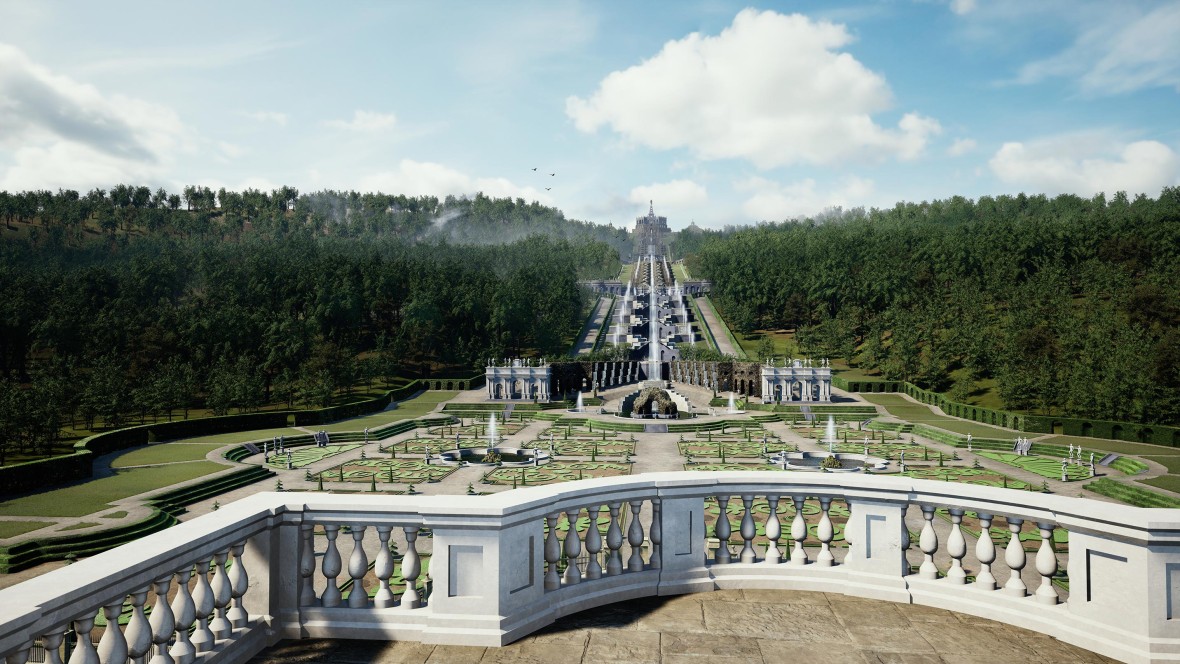Bergpark reloaded
10 years UNESCO World Heritage
2023/05/19
From 21 May and until 17 September 2023, Hessen Kassel Heritage will be taking visitors to Wilhelmshöhe Palace on a virtual journey back to the origins of Bergpark Wilhelmshöhe. The exhibition “Bergpark reloaded” shows, among other things, a virtual insight into the actual construction plans of Landgrave Carl and thus offers visitors the opportunity to immerse themselves in a cultural landscape of superlatives. The digital model of the Bergpark was created in cooperation with the TU Darmstadt, Department of Digital Design, and provides a fascinating insight into this gigantic baroque building project.
Bergpark reloaded
From 21 May and until 17 September 2023, Hessen Kassel Heritage will be taking visitors to Wilhelmshöhe Palace on a virtual journey back to the origins of Bergpark Wilhelmshöhe. The exhibition “Bergpark reloaded” shows, among other things, a virtual insight into the actual construction plans of Landgrave Carl and thus offers visitors the opportunity to immerse themselves in a cultural landscape of superlatives. The digital model of the Bergpark was created in cooperation with the TU Darmstadt, Department of Digital Design, and provides a fascinating insight into this gigantic baroque building project.
For ten years now, Bergpark Wilhelmshöhe has been part of the universal World Heritage of Humanity. With its inclusion, UNESCO thus honored the garden monument as a unique cultural landscape as well as the fountains and the Hercules as an extraordinary and unique example of monumental architecture of European absolutism. The exhibition “Bergpark Reloaded” focuses on the Baroque beginnings of the Bergpark and inquires into the original planning, which has survived in four sources, some of which agree and some of which contradict each other: the engraving by Guerniero himself, eight paintings by Jan and Rymer van Nickelen, three medals that Landgrave Carl and his successors had minted on the Bergpark, and the cross-section and ground plan of the new “model house” planned at the Königstor in 1780.
(Re)constructed – The great cascade project
Based on the series of paintings by Jan and Rymer van Nickelen, which show an ideal image of Landgrave Carl's cascade project in eight large-scale panoramas, a digital model of the facilities has been (re)constructed since 2021. A small team of the Digital Design Department of the TU Darmstadt and Hessen Kassel Heritage took up the challenge to add another presentation to the historically handed down idea. In the process, the design reproduced in the paintings was taken up, as was the mood conveyed there. The main challenge was to find a plausible design for the parts of the complex that were not visible. An exciting result of the work is also that it can now be said that the layout was apparently very well planned in advance. It probably could have been built almost entirely without impossible interference with the natural terrain. The result is a complete digital image of the complex, just as Landgrave Carl probably wanted it. In the exhibition, the digital model will be on permanent display in a high-resolution film. Selected guided tours will include an interactive virtual tour of this baroque architecture.
Background to the planning, which was only partially realized
The first plans for a monumental complex on the slope of the Habichtswald can be traced back to the 1680s. However, it was not until Landgrave Carl appointed the Italian Giovanni Francesco Guerniero in 1701 that the building project gained momentum. He designed a complex that would have extended from the Hercules building to today's Wilhelmshöhe Palace, but was only partially realized. Guerniero completed the octagon, including the pyramid and statue of Hercules, the grottoes in the upper section and the cascades before returning to Rome in 1715. As a result, the building project came to a standstill and only Carl's successors continued to plan and build it. Landgrave Frederick II created numerous park buildings and Landgrave Wilhelm IX – later Elector Wilhelm I – had the Baroque water features supplemented from the end of the 18th century by monumental water pictures in the sense of an English landscape garden.
The lost model of the Bergpark
As historical travel reports prove, a model of the Bergpark could be seen in Kassel at the beginning of the 18th century. Temporarily exhibited in the so-called Kunsthaus, a scientific museum founded by Landgrave Carl (today the Museum of Natural History in the Ottoneum), it was later displayed in the so-called Modellhaus. Assembled, it had considerable dimensions of about 63 m long, about 10 m high and about 6 m wide. In addition to the realized water arts, it was one of the great attractions of Kassel. In 1808, during the reign of King Jérôme Bonaparte, it was dismantled and disassembled into individual parts. Like many other models from the former model house, it is irretrievably lost.
What this model looked like and what it showed is still one of the unanswered questions in mountain park research. It is very likely that Jan and Rymer van Nickelen took it as a starting point for their series of paintings. Whether the painters faithfully reproduced it or further embellished it for the glory of the landgrave, however, can no longer be clarified with certainty.











